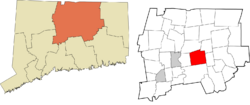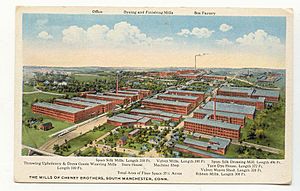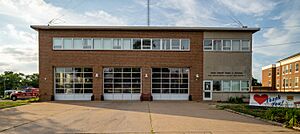Manchester, Connecticut facts for kids
Quick facts for kids
Manchester, Connecticut
|
|||
|---|---|---|---|
| Town of Manchester | |||
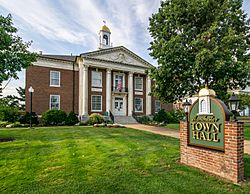
Town Hall
|
|||
|
|||
| Nickname(s):
Silk City
|
|||
| Motto(s):
"City of Village Charm"
|
|||
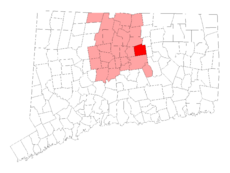 Hartford County and Connecticut Hartford County and Connecticut |
|||
| Country | |||
| U.S. state | |||
| County | Hartford | ||
| Region | Capitol Region | ||
| Founded | 1672 | ||
| Incorporated | 1823 | ||
| Government | |||
| • Type | Council–manager | ||
| Area | |||
| • Total | 27.7 sq mi (71.7 km2) | ||
| • Land | 27.3 sq mi (70.6 km2) | ||
| • Water | 0.4 sq mi (1.1 km2) | ||
| Elevation | 272 ft ((at Town Hall) 82.9 m) |
||
| Population
(2020)
|
|||
| • Total | 59,713 | ||
| • Density | 2,191/sq mi (845.8/km2) | ||
| Time zone | UTC−5 (EST) | ||
| • Summer (DST) | UTC−4 (EDT) | ||
| ZIP Codes |
06040–06042, 06045
|
||
| Area code(s) | 860/959 | ||
| FIPS code | 09-44700 | ||
| GNIS feature ID | 213455 | ||
| Interstates | |||
| List of auxiliary Interstate Highways | |||
| U.S. Highways | |||
Manchester is a town in Connecticut, a state in the United States. In 2020, about 59,713 people lived here. The town is named after Manchester, a city in England.
Contents
History of Manchester
Long ago, the area where Manchester is now was home to a peaceful Native American tribe called the Podunk. Around 1673, settlers from Europe arrived. This was about 40 years after Thomas Hooker and his group founded Hartford.
Back then, the area was called Orford Parish. You can still see this name on a memorial for soldiers from the American Revolutionary War. Many rivers and streams here helped power factories. This made Manchester grow into an important industrial town.
The land that is now Manchester was once part of Hartford. In 1783, East Hartford became a separate town. Manchester was part of East Hartford until 1823, when it became its own town.
Early Industries in Manchester
The Pitkin Glassworks made glass from 1783 to 1830. It was the first successful glass factory in Connecticut. The owner, Captain Richard Pitkin, was given a special right to make glass for 25 years. This was a reward for providing gunpowder during the American Revolution. Today, the Pitkin Glassworks Ruin is a preserved historical site.
In 1838, the Cheney family started a silk mill. It grew to be the largest silk mill in the world. The Cheney family hired many people, including immigrants, to work in their mills. This made Manchester a busy industrial community. The old mills, along with the homes of the owners and workers, are now part of the Cheney Brothers Historic District. This area is a National Historic Landmark.
Another important factory was the E.E. Hilliard Company Woolen Mills. This mill started around 1780 and is the oldest woolen mill site in the country.
Geography of Manchester
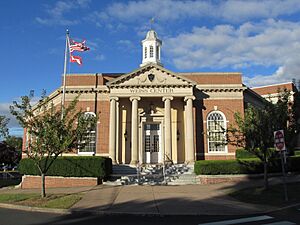
Manchester covers about 27.7 square miles (71.7 square kilometers). Most of this area, about 27.3 square miles (70.6 square kilometers), is land. The rest, about 0.4 square miles (1.1 square kilometers), is water.
People of Manchester
| Historical population | |||
|---|---|---|---|
| Census | Pop. | %± | |
| 1850 | 2,546 | — | |
| 1860 | 3,294 | 29.4% | |
| 1870 | 4,223 | 28.2% | |
| 1880 | 6,462 | 53.0% | |
| 1890 | 8,222 | 27.2% | |
| 1900 | 10,601 | 28.9% | |
| 1910 | 13,641 | 28.7% | |
| 1920 | 18,370 | 34.7% | |
| 1930 | 21,973 | 19.6% | |
| 1940 | 23,799 | 8.3% | |
| 1950 | 34,116 | 43.4% | |
| 1960 | 42,102 | 23.4% | |
| 1970 | 47,994 | 14.0% | |
| 1980 | 49,761 | 3.7% | |
| 1990 | 51,618 | 3.7% | |
| 2000 | 54,740 | 6.0% | |
| 2010 | 58,241 | 6.4% | |
| 2020 | 59,713 | 2.5% | |
| U.S. Decennial Census | |||
In 2000, about 54,740 people lived in Manchester. The town had many different kinds of families and households. About 28% of households had children under 18. The average age of people in Manchester was 36 years old.
Economy and Jobs
Manchester was once famous for its silk industry. The Cheney family's silk mill was a huge part of the town's success. Today, the old mills in the Cheney Brothers Historic District have been turned into apartments and museums.
Top Employers in Manchester
Many people work for the Town of Manchester itself. Other big employers include hospitals, colleges, and large companies. Here are some of the top places to work in Manchester:
| # | Employer | # of Employees |
|---|---|---|
| 1 | Town of Manchester | 1,918 |
| 2 | Prospect ECHN | 1,500 |
| 3 | Manchester Community College | 960 |
| 4 | Ahold Delhaize USA | 550 |
| 5 | Amazon | 500 |
| 6 | Allied Printing | 362 |
| 7 | Flex LTD | 355 |
| 8 | Paradigm | 350 |
| 9 | Macy's | 300 |
| 10 | Walmart | 300 |
Manchester also has a large shopping mall called The Shoppes at Buckland Hills. There is also a famous restaurant called Shady Glen. It is known for its classic American food.
Arts and Culture
Manchester has a rich history of arts and culture.
Music and Theater
The Manchester Pipe Band is the second-oldest pipe band in the United States. It started in 1914. Cheney Hall is home to The Little Theater of Manchester. This community theater group has been performing for over 60 years. The Manchester Symphony Orchestra and Chorale also performs and teaches music to young people.
Museums in Manchester
Manchester has four interesting museums:
- The Fire Museum shows old firefighting equipment. You can see leather fire buckets from colonial times and a 1921 fire truck.
- The Lutz Children's Museum has hands-on exhibits about art, history, science, and nature. It also has small live animals.
- The Old Manchester Museum focuses on local history. It has examples of Cheney silk, Pitkin glass, and old rifles. It also has the Manchester Sports Hall of Fame.
- The Cheney Homestead Museum is an old house from the 1700s. It belonged to the family who started the silk company. You can see old furniture and art there. There is also a one-room schoolhouse from 1751.
Parks and Recreation
Wickham Park is a large park with beautiful gardens and trails. The Oak Grove Nature Center has rivers, ponds, and hiking trails. It also offers nature classes for children. Case Mountain Recreational Area is great for hiking and mountain biking. It has amazing views of the Hartford skyline. Charter Oak Park in downtown Manchester has courts for basketball, softball, and tennis. It also has soccer fields and a musical garden.
Annual Events
The annual auto show Cruisin' on Main Street happens every August. It is one of the biggest car shows in the Northeast. It features over 14,000 old and rare cars. This event also helps provide scholarships for local high school students.
Sports in Manchester
Manchester has a strong sports tradition.
Golf
Manchester Country Club opened in 1917. It has a classic New England golf course design. The club hosts an annual open tournament.
Running
The Manchester Road Race is a famous 4.748-mile race. It takes place every Thanksgiving morning. Over 10,000 people, including Olympic athletes, participate. It is the second most popular race in New England, after the Boston Marathon. The race started in 1927 and helps many charities.
Baseball
The Manchester Silkworms were a summer baseball team for college players. They were named after the town's history of silk production. Some players from the Silkworms went on to play in Major League Baseball.
Education in Manchester
Manchester offers many schools for students of all ages.
Public Schools
- High Schools: Manchester High School, Howell Cheney Technical High School, Bentley Alternative Education School, Great Path Academy (Magnet)
- Middle Schools: Arthur H. Illing Middle School, Manchester Middle Academy, Elisabeth M. Bennet Academy
- Elementary Schools: William E. Buckley, Bowers, Highland Park, Keeney Street, Martin, Verplanck, Waddell, Discovery Academy (Magnet)
- Preschool: Manchester Preschool Center, Discovery Academy (Magnet)
Private Schools
- Saint Bridget School (Pre-K–8)
- Saint James School (Pre-K–8)
- East Catholic High School (9–12)
- The Cornerstone Christian School (Pre-K–12)
College
Manchester Community College is a two-year college located in town.
Media
Manchester has its own local newspaper, the Journal Inquirer. The Hartford Courant also has a facility in Manchester.
Emergency Services
Manchester has dedicated teams to keep its residents safe.
Manchester Fire Department
The Manchester Fire Department is a full-time department. It operates from seven firehouses. They provide many services, including putting out fires, rescuing people from accidents, and handling dangerous materials. They also provide advanced medical care. The department was formed on July 1, 2023, when two older fire departments merged.
Police Department
The Manchester Police Department started in 1896. It has about 120 officers. The department is led by Chief William Darby.
The police department has three main parts:
- Field Services: This includes the officers who patrol the town 24/7. They respond to calls, investigate accidents, and enforce traffic laws. This division also has special units like the K-9 Unit and School Resource Officers.
- Support Services: This part handles things like the 911 dispatch center, records, and training.
- Administrative Services: This division manages the budget and makes sure the department follows professional standards.
The Manchester Police Department is also part of the Capital Region Emergency Services Team (CREST). This is a special team of highly trained officers from several towns. They respond to serious situations like hostage incidents or high-risk arrests.
Medical Transport
Ambulance Service of Manchester (ASM) is a private company. They provide ambulance services and medical care. They can also provide advanced medical care when fire department paramedics are not available.
Transportation
Manchester has several ways to get around.
Roads
Major highways like I-84, I-384, and I-291 pass through Manchester. Route 6 and Route 44 are important roads for traveling east and west. Connecticut Route 83 is the main road for traveling north and south through the town.
Public Transportation
Buses from Connecticut Transit connect Manchester to Hartford.
Rail
There is no passenger train service in Manchester right now. The closest train station is Union Station in Hartford. Freight trains do use the tracks in Manchester.
Airports
Bradley International Airport is about 20 minutes north of Hartford. It has many daily flights to different places. Other nearby airports include Hartford–Brainard Airport and Tweed New Haven Airport.
Bicycling
Manchester has several bike paths. The Charter Oak Greenway and the Hop River State Park Trail are very popular. Parts of these paths are also part of the East Coast Greenway, a long trail along the East Coast.
Notable People from Manchester
Many interesting people have come from Manchester:
- Nathan Agostinelli – Former mayor and State Comptroller.
- Geno Auriemma – Coach of the UConn women's basketball team.
- Daniel C. Burbank – A NASA astronaut.
- Seth DeValve – A professional football player.
- Jean Marzollo – A children's author and illustrator.
- Henry Molaison – A famous patient who helped scientists learn about memory.
- Fred Norris – A radio personality on The Howard Stern Show.
- Alberto Salazar – A former world-class long-distance runner.
- Christopher Spencer – The inventor of the Spencer repeating rifle.
- Dana White – The president of the Ultimate Fighting Championship.
See also
In Spanish: Manchester (Connecticut) para niños




